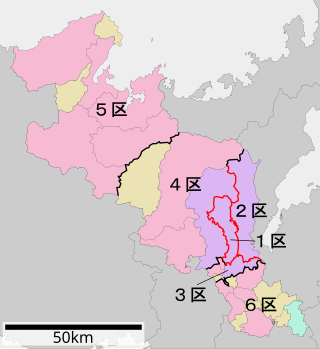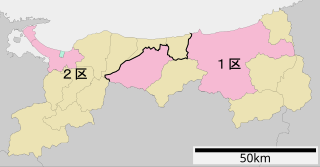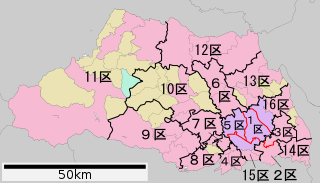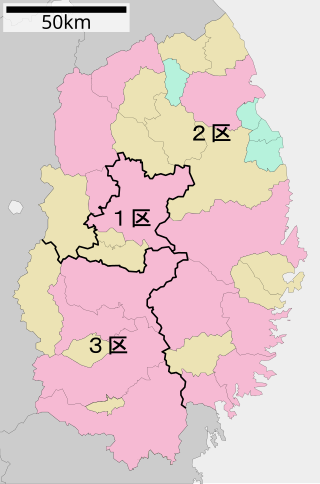Related Research Articles

Gunma 1st District is a single-member constituency of the Japanese House of Representatives, the lower house of the National Diet. It is located in Gunma Prefecture and consists of the cities of Maebashi and Numata and the district of Tone as well as parts of the cities of Kiryū, Shibukawa and Midori. As of 2012, 387,120 eligible voters were registered in the district.

Gunma 5th district is a constituency of the House of Representatives in the Diet of Japan. It is located in Gunma Prefecture and consists of the cities of Tomioka, Annaka, parts of Takasaki and Shibukawa as well as the Kitagunma, Kanra and Agatsuma districts. As of 2012, 315,747 eligible voters were registered in the district.
Gunma 3rd district was a constituency of the House of Representatives in the Diet of Japan. Between 1947 and 1993 it elected four representatives by single non-transferable vote. As of 1993, it comprised the cities of Takasaki, Shibukawa, Fujioka, Tomioka, Annaka and the Gunma, Kitagunma, Tano, Kanra, Usui and Agatsuma districts.

Gunma At-Large District is a constituency of the House of Councillors in the Diet of Japan. It consists of Gunma Prefecture and elects two Councillors, one per election.
Wakayama 3rd district is a constituency of the House of Representatives in the Diet of Japan. It is located in Wakayama Prefecture and consists of Arida, Gobo, Shingu, and Tanabe cities and the Arida, Hidaka, Higashimuro, and Nishimuro districts. As of 2012, 298,296 eligible voters were registered in the district.

The Tokyo 3rd district is a constituency of the House of Representatives in the Diet of Japan. It is located in Tokyo and covers parts of the former city of Tokyo and Tokyo's outlying islands. The district consists of the wards of Shinagawa and parts of Ōta, the towns of Ōshima and Hachijō and the villages of Toshima, Niijima, Kōzushima, Miyake, Mikurajima, Aogashima and Ogasawara. As of 2012, 482,494 eligible voters were registered in the district.

Tokyo 2nd district is a constituency of the House of Representatives in the Diet of Japan. It is located in eastern mainland Tokyo and covers central parts of the former Tokyo City. The district consists of the wards of Chūō, Bunkyō and Taitō. As of 2012, 424,273 eligible voters were registered in the district.

Chiba 4th district is a constituency of the House of Representatives in the Diet of Japan. It is located in the city of Funabashi in Western Chiba. As of 2016, 459,431 eligible voters were registered in the district. In the 2009 and 2012 general elections, the district had the lowest electoral weight throughout Japan at more than two times as many voters as the district with the highest electoral weight, Kōchi-3rd.
Nagasaki 1st district is a constituency of the House of Representatives in the Diet of Japan. It is located in Southwestern Nagasaki and covers the city of Nagasaki without the former towns of Kinkai and Sotome. As of 2009, 353,871 eligible voters were registered in the district.

Kyōto 3rd district is a constituency of the House of Representatives in the Diet of Japan. It is located in South central Kyoto and consists of Kyoto city's Fushimi ward, the cities of Mukō and Nagaokakyō and the town of Ōyamazaki. As of 2012, 345,260 eligible voters were registered in the district.
Hiroshima 7th District is a constituency of the House of Representatives in the Diet of Japan. It is located in Hiroshima and consists of the city of Fukuyama. As of 2012, 377,672 eligible voters were registered in the district.

Tottori 1st district is a constituency of the House of Representatives in the Diet of Japan.

Saitama 3rd district is a constituency of the House of Representatives in the Diet of Japan. It is located in Southeastern Saitama and consists of the cities of Kawaguchi and Koshigaya. As of 2012, 460,884 eligible voters were registered in the district.

Kagoshima 3rd Districtis a single-member constituency of the House of Representatives in the Diet of Japan. It is located in Northern Kagoshima and consists of the cities of Akune, Izumi, Satsumasendai, Hioki, Ichikikushikino, Isa and Aira as well as the towns of Satsuma, Nagashima and Yūsui. In 2021 the district had 319,010 eligible voters.

Gunma 4th district is a single-member constituency of the House of Representatives in the Diet of Japan. It is located in Southern Gunma and consists of the city of Fujioka, the Southern part of Takasaki city as well as Kanna town and Ueno village in Tano county. As of 2009, 292,356 eligible voters were registered in the district.

Tōkyō 25th district is a constituency of the House of Representatives in the Diet of Japan. It is located in the westernmost part of Tokyo prefecture. In of 2012, 321,319 eligible voters were registered in the district giving it the highest vote weight in Tokyo – several districts in former Tokyo city in Eastern Tokyo have more than 450,000 voters – but still more than 1.5 times as many voters as the least populated electoral districts in Japan.

Iwate 1st district is a single-member constituency of the House of Representatives in the Diet of Japan. It is located in central Iwate and consists of the prefectural capital Morioka city and the two remaining towns in Shiwa district. Before 2017, it covered of the majority of the prefectural capital Morioka and Shiwa district. As of 2012, 278,860 eligible voters were registered in the district.
Nagasaki 3rd district is a single-member electoral district for the House of Representatives, the lower house of the National Diet of Japan. It is located in the prefecture of Nagasaki. It covers parts of Nagasaki on the main island of Kyūshū – the city of Ōmura and the towns of Kawatana, Hasami and Higashisonogi, Nagasaki in former Higashi-Sonogi-gun – and several of the prefecture's island municipalities: the cities of Iki, Tsushima and Gotō and the town of Shin-Kamigotō in Minami-Matsuura/"South Matsuura" district. As of September 2011, 211,289 eligible voters were registered in Nagasaki 3rd district, giving it the second highest vote weight in the country.

Gunma 2nd District is a single-member constituency of the Japanese House of Representatives, the lower house of the National Diet. It is located on the island of Honshu, in Gunma Prefecture, and includes the cities of Isesaki and Kiryu, among others.

Gunma 3rd district is a single-member constituency of the House of Representatives in the Diet of Japan. It is located in south-eastern Gunma and consists of Ota, Tatebayashi and Ōra County.